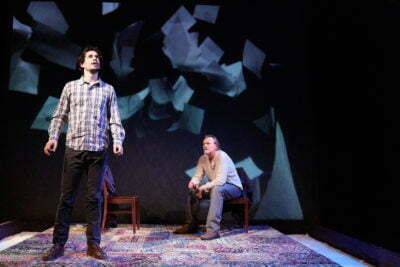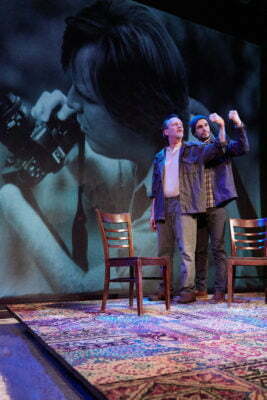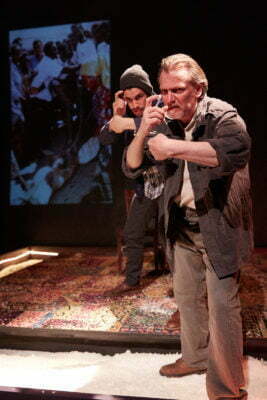The Body of an American
 By Dan O’Brien
By Dan O’Brien
Directed by Jason A. Fleece
Produced by Stage Left Theatre
Playing at Theater Wit, Chicago
Open-Ended Docudrama Examines the Power of Observance
It is well-known how easily a play about itself can go awry, especially when it contains heavy use of unusual performance techniques. However, writer Dan O’Brien knew that the story of his relationship with war photojournalist Paul Watson defied conventional narratives—it’s messy, inconclusive, and made up of snapshots taken from chaos. Fortunately, Stage Left director Jason A. Fleece knows just how to handle his two-man cast and team of designers to make each moment of the story clear and effective. Against the background of the shooting down of American Black Hawk helicopters in Somalia in 1993, as well as the threatened serenity of the Arctic, two men explore the ethics of their professions, and what drives them to keep on sharing theirs and other peoples’ dysfunctions with the world.

The photograph Canadian Paul Watson (Don Bender) took of Staff Sergeant William Cleveland’s body being dragged by an enraged crowd in Mogadishu won him a Pulitzer Prize, and was a major influence on Bill Clinton’s decision to withdraw from the United Nations mission in Somalia. Though he was experienced in documenting carnage, Watson knew, as he photographed Cleveland, that the man’s ghost would haunt him forever. When struggling young playwright Dan O’Brien (Ryan Hallahan) emails him in 2007 to talk about his memoir, Watson surprises him by responding, and the two begin exchanging stories over several years. However, it’s slow going to get Watson to open up fully about his life, and in truth, O’Brien isn’t sure what, exactly, he’s looking for. Though he’s never been to a warzone, O’Brien suffers from PTSD of his own due to a family history of mental illness and watching his brother’s suicide attempt. While Watson’s stories about feeling literally haunted and encountering many different ways people around the world process or ignore trauma are interesting, after a while, O’Brien starts wondering if he’s pressuring Watson for wisdom the reporter can’t provide, or if he just doesn’t find the truth satisfactory. It takes a surprising turn of events for him to conclude his play is finished enough.
 Between them, Bender and Hallahan play about thirty characters, but most of the roles only exist during the span of a few short phrases. Their main characters are always welcome reprises after humorous or alarming diversions into the oddball supporting cast, with Bender giving Watson the put-on Hemingwayesque swagger O’Brien complains about, and Hallahan providing O’Brien with the tense remoteness that puzzles Watson. The most difficult part of O’Brien’s dialogue is when each man narrates the other’s subconscious, but these moments go by so quickly that the audience has no time to be confused. Paul Watson has a deformed hand which Bender mimics simply by clenching his fist; very quickly, this simple gesture is all it takes for Watson to materialize from nowhere after Bender has been playing someone else or lurking in the stage’s dark spots. Likewise, during a scene in which Hallahan plays Sgt. Cleveland’s brother, his transformation is so complete that it seems like another actor has walked out for the first time. While each has a few monologues, the way in which the actors reinforce their rapid transformations while together is a most impressive feat of acting.
Between them, Bender and Hallahan play about thirty characters, but most of the roles only exist during the span of a few short phrases. Their main characters are always welcome reprises after humorous or alarming diversions into the oddball supporting cast, with Bender giving Watson the put-on Hemingwayesque swagger O’Brien complains about, and Hallahan providing O’Brien with the tense remoteness that puzzles Watson. The most difficult part of O’Brien’s dialogue is when each man narrates the other’s subconscious, but these moments go by so quickly that the audience has no time to be confused. Paul Watson has a deformed hand which Bender mimics simply by clenching his fist; very quickly, this simple gesture is all it takes for Watson to materialize from nowhere after Bender has been playing someone else or lurking in the stage’s dark spots. Likewise, during a scene in which Hallahan plays Sgt. Cleveland’s brother, his transformation is so complete that it seems like another actor has walked out for the first time. While each has a few monologues, the way in which the actors reinforce their rapid transformations while together is a most impressive feat of acting.
 Although the play has only two actors, it is visually rich, thanks to Anthony Churchill’s scenic and projection designs. The stage contains a Persian carpet surrounded by snow, and the scenes in the Artic, away from the bloodshed that the playwright imagines in Watson’s memory, are where O’Brien comes as close as he gets to discovering a reason for his troubles. This being a true-to-life play, there are no neat answers, but there are realizations. Watson agonizes over whether his photograph inspired jihadists’ increased use of propaganda of the deed. Would terrorists attempt to influence other countries through beheading videos if his photo hadn’t resulted in a victory for them? Or might he have been able to save more lives if he’d published the truth sooner? O’Brien allows him to ask tough questions, and Stage Left holds conversations after Sunday matinee performances at which audiences may debate them. The Body of an American is a story which asks us to consider how we get our information about the world, and is a fantastic study of two rich characters examining the question along with us.
Although the play has only two actors, it is visually rich, thanks to Anthony Churchill’s scenic and projection designs. The stage contains a Persian carpet surrounded by snow, and the scenes in the Artic, away from the bloodshed that the playwright imagines in Watson’s memory, are where O’Brien comes as close as he gets to discovering a reason for his troubles. This being a true-to-life play, there are no neat answers, but there are realizations. Watson agonizes over whether his photograph inspired jihadists’ increased use of propaganda of the deed. Would terrorists attempt to influence other countries through beheading videos if his photo hadn’t resulted in a victory for them? Or might he have been able to save more lives if he’d published the truth sooner? O’Brien allows him to ask tough questions, and Stage Left holds conversations after Sunday matinee performances at which audiences may debate them. The Body of an American is a story which asks us to consider how we get our information about the world, and is a fantastic study of two rich characters examining the question along with us.
Highly Recommended
Jacob Davis
Reviewed May 18, 2016
This show has been Jeff recommended.
For more information, see The Body of an American’s page on Theatre in Chicago.
Playing at Theater Wit, 1229 W Belmont, Chicago. Tickets are $20-30; to order, call 773-975-8150 or visit stagelefttheatre.com. Performances are Thursdays-Saturdays at 8:00 pm, and Sundays at 3:00 pm through June 19. Running time is ninety-five minutes with no intermission.

